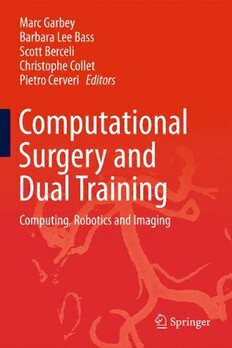Table Of ContentMarc Garbey
Barbara Lee Bass
Scott Berceli
Christophe Collet
Pietro Cerveri Editors
Computational
Surgery and
Dual Training
Computing, Robotics and Imaging
Computational Surgery and Dual Training
Marc Garbey • Barbara Lee Bass (cid:129) Scott Berceli
Christophe Collet (cid:129) Pietro Cerveri
Editors
Computational Surgery
and Dual Training
Computing, Robotics and Imaging
123
Editors
MarcGarbey BarbaraLeeBass
DepartmentofComputerScience DepartmentSurgery
UniversityofHouston TheMethodistHospitalResearchInstitut
Houston,TX,USA Houston,TX,USA
ScottBerceli ChristopheCollet
DepartmentofSurgery Labo.Sciencesdel’Images,de
UniversityofFloridaCollegeofMedicine UniversitéStrasbourgIENSPS
Gainesville,FL,USA Illkirch,France
PietroCerveri
BiomedicalEngineeringDepartment
PolitecnicodiMilano
Milano,Italy
ISBN978-1-4614-8647-3 ISBN978-1-4614-8648-0(eBook)
DOI10.1007/978-1-4614-8648-0
SpringerNewYorkHeidelbergDordrechtLondon
LibraryofCongressControlNumber:2013953712
©SpringerScience+BusinessMediaNewYork2014
Thisworkissubjecttocopyright.AllrightsarereservedbythePublisher,whetherthewholeorpartof
thematerialisconcerned,specificallytherightsoftranslation,reprinting,reuseofillustrations,recitation,
broadcasting,reproductiononmicrofilmsorinanyotherphysicalway,andtransmissionorinformation
storageandretrieval,electronicadaptation,computersoftware,orbysimilarordissimilarmethodology
nowknownorhereafterdeveloped.Exemptedfromthislegalreservationarebriefexcerptsinconnection
with reviews or scholarly analysis or material supplied specifically for the purpose of being entered
and executed on a computer system, for exclusive use by the purchaser of the work. Duplication of
this publication or parts thereof is permitted only under the provisions of the Copyright Law of the
Publisher’slocation,initscurrentversion,andpermissionforusemustalwaysbeobtainedfromSpringer.
PermissionsforusemaybeobtainedthroughRightsLinkattheCopyrightClearanceCenter.Violations
areliabletoprosecutionundertherespectiveCopyrightLaw.
Theuseofgeneraldescriptivenames,registerednames,trademarks,servicemarks,etc.inthispublication
doesnotimply,evenintheabsenceofaspecificstatement,thatsuchnamesareexemptfromtherelevant
protectivelawsandregulationsandthereforefreeforgeneraluse.
While the advice and information in this book are believed to be true and accurate at the date of
publication,neithertheauthorsnortheeditorsnorthepublishercanacceptanylegalresponsibilityfor
anyerrorsoromissionsthatmaybemade.Thepublishermakesnowarranty,expressorimplied,with
respecttothematerialcontainedherein.
Printedonacid-freepaper
SpringerispartofSpringerScience+BusinessMedia(www.springer.com)
Preface
While a concept in evolution, Computational Surgery is a new discipline that
focuses on the application of medical imaging, robotics, biological modeling,
simulation, and information technology in surgical treatment of patients. The
COSINEconsortium(computationalsurgery.org)foundedin2008aimstoproduce
anewbreedofengineersandscientistswhocanpartnerwithphysicianstoevolvethe
nextgenerationofsurgicalcare.Thiseffort,fueledbytheurgentneedexpressedby
thoughtleadersinthemedicaldeviceindustry,seekstofacilitatetherapidevolution
toward computer-assisted surgical-based therapies. At a time where the medical
budget of advanced countries is the fastest growing sector of the economy, the
challengetoimproveefficiencywhilemaintainingthequalityofcarerequiresnew
and innovativesolutions. As stated in the inaugural2010issue of this book,“The
futureofsurgeryisintrinsicallylinkedtothefutureofcomputationalsciences:the
medicalact will be computer assisted at every single step, from planningto post-
surgeryrecoveryandthroughthesurgicalprocedureitself.”Theunderpinningofthe
sentimentsis evenmoretruetoday,with this secondissue offeringa moremature
pictureofafieldthatistakingrootina varietyofcoredisciplines.Asacollective
groupfocus,researchinterestsencompassbutarenotlimitedtothefollowingareas:
(cid:129) Modelingandsimulationtopredictsurgicaloutcomes
(cid:129) Real-timesimulationtoaugmentoperatingroomprocedures
(cid:129) Designofnewmedicaldevicestomeetproceduralneeds
(cid:129) Integrationofpatient-specificdatatoproceduralplanningandoutcomes
(cid:129) Multi-scalemodelingofsurgicaldisease
In the currentissue, we presentrecentprogressesin fourcomplementaryfields
ofcomputationalsurgery:
1. ModelingandSimulationofSurgicalProcedures
2. RoboticandImage-GuidedSurgicalIntervention
3. ImageAnalysisandVisualizationforSurgicalPlanning
4. InformationTechnologyasaFrameworkforSurgicalDecisionMaking
v
vi Preface
AmongtheprimarygoalsofthisbookistopromotethedevelopmentofCyber-
Infrastructurein the operatingroom, with a particular emphasis on computational
methods to optimize the integration of procedural technologies, informatics, and
human factors to maximize the delivery of surgical care. We are taking a holistic
viewoftheoperatingroomtowardanintegratedplatformthatcombinessimulation,
imaging,androboticsintoanewframeworkforsurgeonsandengineers,requiring
new skills and promising interactions. This book provides a strategic view for
developing a cross discipline curriculum in computational surgery aimed at two
disciplines:
(cid:129) Computationalscientistsandengineersmotivatedtocollaboratewithsurgeonsto
improvethestateoftheart.
(cid:129) Surgeons who are interested in the cutting-edge computational technology
innovationsthatdrivemedicalimaging,robotics,andvirtualsurgerysimulation.
Following the introduction, which offers a roadmap to achieve this goal, the
book is organized into five parts that address successively the computer-assisted
management of disease and surgery, the role of image processing in diagnostic
and/or intervention, the image driven intervention and robotic, the contribution
of modeling and simulation to surgery, and finally the training and performance
analysis inherentto this new technology.We have made special efforts to include
extended review chapters that define the landscape of the medical knowledge
requiredtofacilitatethedialogbetweenspecialties.OurspecialthanksgotoBrian
Butler,ShandaBlackmon,MarkDavies,MinPKim,AlanB.Lumsden,BinSTeh
from the Methodist Hospital and William W. Lytton from the Downstate Medical
Center,who have providedmuch of the informationprovidedin this contribution.
Other chapters address various innovative computational methods and techniques
for surgery improvement, some intended to rapidly open the path toward new
practices,andothersdesignedtooutlinecriticalareasofactiveresearchthatrequire
additionaldevelopmentpriortointegrationintoeverydaylifesurgicalpractice.
Part II of this book discusses the computer-assisted management of disease
throughmedicalimagingandimageanalysis.Detailedinthefirstchapterisastate-
of-the-art virtual reality environment dedicated to the comprehensive planning of
surgicalandinterventionaltherapies.Thefollowingchapterdescribesthe applica-
tionofcomputer-aidedanalysisintheplanninganddeliveryofradiotherapythrough
useofanintegratedsystemthatsimultaneouslyimagesthepatientandcontrolsthe
localdeliveryofradiation.Thefinalchapterofthissectiondemonstratestheroleof
modelingand simulationto predictthe cosmetic outcomefollowinglocalsurgical
treatmentofbreastcarcinoma.
Part III examines approaches aimed at improving the real-time connection
between diagnostic imaging and the delivery of care. In this section, we engage
thecomplexityofmultivariatedata,requiringbothefficientmodelingtoreconstruct
compleximagesandadvancedinformaticstofacilitatetherapidcommunicationof
complexdatasets.Drivingthisworkisthedevelopmentofabetterandfastertoolto
guidesurgicalintervention.
Preface vii
PartIVbuildsuponautomaticimageprocessingandreal-timeimageguidanceto
drivesophisticatedandcomplexinterventions.Thispartlooksatfourcomplemen-
tary fields of application: cardiovascular intervention, orthopedic reconstructions,
lungcancerresection,andabdominalendoscopy.Thecommonalitybetweenthese
divergentdisciplinesistheextensiveuseofcomputersandalgorithmstoobtainthe
most accurate and efficient minimally invasive procedures.It is a fascinating area
ofresearchwheremedicalimaging,innovativeprocessingmethods,andadvanced
robotic devicescome togetherwith simulation algorithmsto optimize controland
maneuverability.The recentintroductionof arthroplastyusing personalizedresec-
tionguidesisanexcellentexampleofthesechallenges,whereefficientandrobust
methodsarerequiredtoextractclinicallandmarksfromdiagnosticimagestoreduce
uncertainty and increase the reliability of the intervention. Similarly, innovative
technologiesexploitingminiaturizedandsmartrobotsareofferingopportunitiesto
gain access to the internal body, through access points that can be quite remote
from the region of interest, reducing scars, and speeding up postoperative patient
recovery.
Part V returns to the fundamental understanding of disease. Through the
mathematical modeling of tissue adaptation and repair, therapeutic opportunities
to improve outcomes can be identified. Fundamental to this approach is a model
thatissufficientlyaccuratetoprovidereliablepredictionyetrobustenoughtowork
onavailableclinicaldata.Severalapplicationsfromcardiovascularinterventionto
cancermanagement,fromneurologicdiseasetoboneassessment,arereviewed.
Finally, Part VI discusses the fundamental aspect of training in surgery and
the use of computational approaches to assess clinical competence. An improved
understandingoftheintegrationandimplementationoftechnologyintheoperating
roomiscriticaltooptimizingtheefficiencyprocedures.
Our hope in detailing general concepts and reporting specific examples in
computationalsurgeryistobothgrowfieldandbringtogethermodeling,computing,
robotics,andimagingintooptimalsurgicalplatform.Sciencediscoveryinmodern
surgery will benefit from this unique dialogue initiative between a community of
surgeonsand computationalscientists. Finally we would like to thank the Partner
UniversityFund(PUF),theAtlantisprogram,andtheJohnF.andCarolynBookout
DistinguishedEndowedchairinsupportofthisteamproject.
Houston,TX,USA MarcGarbey
Houston,TX,USA BarbaraLeeBass
Gainesville,FL,USA ScottBerceli
Illkirch,France ChristopheCollet
Milano,Italy PietroCerveri
Contents
PartI Introduction
1 A RoadMapforComputationalSurgery:Challenges
andOpportunities.......................................................... 3
B.L.BassandM.Garbey
PartII Computer Assisted Management of Disease
andSurgery
2 Plato’sCAVE: A Multidimensional, Image-Guided
RadiationTherapyCrossRealityPlatformwithAdvanced
Surgical Planning, Simulation, and Visualization
TechniquesUsing(Native)DICOMPatientImageStudies............ 27
E.BrianButler,PaulE.Sovelius,andNancyHuynh
3 StereotacticBodyRadiotherapy/StereotacticAblative
BodyRadiotherapyforLungCancer .................................... 37
HuaRen,ShandaBlackmon,andBinS.Teh
4 Computer-AidedManagementinScoliosisSurgery.................... 57
TranNguyenHoangThiTho,TruongQuangDangKhoa,
VoVanThanh,LawrenceH.Le,andVoVanToi
5 ComputationalModelingofBreastConservingSurgery
(BCS)StartingfromMRIImaging....................................... 67
D.Thanoon,M.Garbey,andB.L.Bass
PartIII ImageProcessingandDiagnostics
6 A Statistical Framework for Biomarker Analysis
andHR-MAS2DMetaboliteIdentification.............................. 89
AkramBelghith,ChristopheCollet,andJean-PaulArmspach
ix

